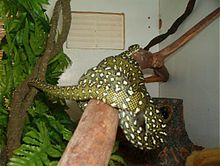- Morelia spilota spilota
-
Morelia spilota spilota 
Scientific classification Kingdom: Animalia Phylum: Chordata Subphylum: Vertebrata Class: Reptilia Order: Squamata Suborder: Serpentes Family: Pythonidae Genus: Morelia Species: M. spilota Subspecies: M. s. spilota Trinomial name Morelia spilota spilota
(Lacépède, 1804)Synonyms - Morelia spilota — Wells & Wellington, 1984
- Morelia spilota spilota — Barker & Barker, 1994[1]
Morelia spilota spilota is a subspecies of carpet python (Morelia spilota), popularly known as the Diamond Python. It is a medium to large snake, found in coastal areas and adjacent ranges of south-eastern Australia. They are the most southerly occurring python in the world and are also found at higher altitudes than any other species of Australian python.
They are quite variable in colour and pattern, typically being predominantly dark olive to black in colour with most dorsal scales having a yellow (or cream) spot in the centre (hence 'spilota' meaning spotted). Along the body and tail are numerous clusters of yellow/cream scales that form 'rosettes' that look a bit like diamonds (hence their common name). The underside is white, cream or even yellowish in colour, although it is often spotted with black.
The average adult size of this subspecies is usually about 2 metres in length, although they are known to reach maximum lengths of about 3 metres, with very rare specimens recorded at up to 4 metres.
They are oviparous snakes, averaging 25 eggs in a clutch and laying up to 54 eggs. The female will defend her eggs by coiling around them and 'shivering' to regulate their temperature. She will not leave the eggs to eat during the incubation period, apart from briefly basking in the sun to raise her body temperature and then returning. Maternal care does not continue once the young have emerged. Juveniles resemble other Morelia spilota, although they become more distinct in their appearance as they mature. [2][3]
Wild diamond python in the Wallingat National Park.
The subspecies is found in southern coastal regions of New South Wales and Victoria.[3] It occurs in a variety of habitats; including heaths, woodland, forest and urban areas. It is known to occupy the roof space of suburban homes, living on mice and rats.[4] It has a limited distribution range in Victoria (Australia), where it is regarded as rare and threatened by reduction in available habitat. Morelia spilota mcdowelli is the only other related python in the state, and is recorded as hybridising with this subspecies in the northern parts of the Diamond Python's range. Morelia spilota spilota occurs at a higher altitude, e.g. in the eastern Gippsland region, than any other member of the Pythonidae family.[2] It is found inland from the coast, but has the most southern distribution of all the Australian subspecies.[2] Few populations are recorded in the state of Victoria and changes in land use have this subspecies listed as threatened with extinction.[2] They are also known to occur in rocky habitat during winter months.[5]
These pythons are ambush predators with large territories that often overlap. They move around these seasonally to occupy well camouflaged positions in the warmer months and brumate in the winter months. The females have a range of up to 50 ha, whilst males may occupy an area almost twice as large. They are often active during the day and on warm nights, although most of their time is spent waiting in ambush for passing prey. They typically remain in one position for up to 2 weeks, before moving to another around 100 metres away.[2] Morelia spilota spilota kill their food by constricting and suffocating it, and will prey on lizards, birds and mammals as large as possums. They are not a danger to humans, but are capable of biting and leaving teeth in the wound if severely harassed.[3]
It is the nominate subspecies for Morelia spilota, a species first described by Lacépède.[6][7]
The Diamond Python is often kept in captivity by collectors in Australia and around the world. The capture of wild specimens is illegal, however they are successfully bred in captivity to supply the demand for this popular reptile. They are usually fed on a diet of rodents and kept in controlled environments such as a vivarium.[8]
References
- ^ McDiarmid RW, Campbell JA, Touré T. 1999. Snake Species of the World: A Taxonomic and Geographic Reference, vol. 1. Herpetologists' League. 511 pp. ISBN 1-893777-00-6 (series). ISBN 1-893777-01-4 (volume).
- ^ a b c d e "Action statement: Diamond Python Morelia spilota spilota ". Flora and Fauna Guarantee Act 1988 No. 104. Department of Sustainability and Environment. http://www.dse.vic.gov.au/CA256F310024B628/0/E9252A5B29C51751CA2570ED0001218E/$File/104+Diamond+Python+2000.pdf. Retrieved 2008-10-20.
- ^ a b c "Diamond Python fact file". Wildlife of Sydney. Australian Museum. 2008. http://australianmuseum.net.au/Diamond-Python. Retrieved 2008-10-20.
- ^ Cogger, Harold G.. Reptiles and Amphibians of Australia.
- ^ Slip, DJ; R Shine (1988). "Habitat Use, Movements and Activity Patterns of Free-Ranging Diamond Pythons, Morelia-Spilota-Spilota (Serpentes, Boidae) — a Radiotelemetric Study". Wildlife Research. CSIRO. http://www.publish.csiro.au/paper/WR9880515.htm. Retrieved 2008-10-20.
- ^ "Morelia spilota spilota". Integrated Taxonomic Information System. http://www.itis.gov/servlet/SingleRpt/SingleRpt?search_topic=TSN&search_value=635071. Retrieved Oct 20, 2008.
- ^ Morelia spilota at the Reptarium.cz Reptile Database. Accessed 17 September 2007.
- ^ "Diamond Pythons (Morelia spilota spilota)". Care Sheet. Monaro Amphibian & Reptile Keepers (MARK). http://www.mark.org.au/pages/cs_diamondpython.htm. Retrieved 2008-10-20.
Categories:- Morelia
- Fauna of Victoria (Australia)
- Fauna of New South Wales
Wikimedia Foundation. 2010.


